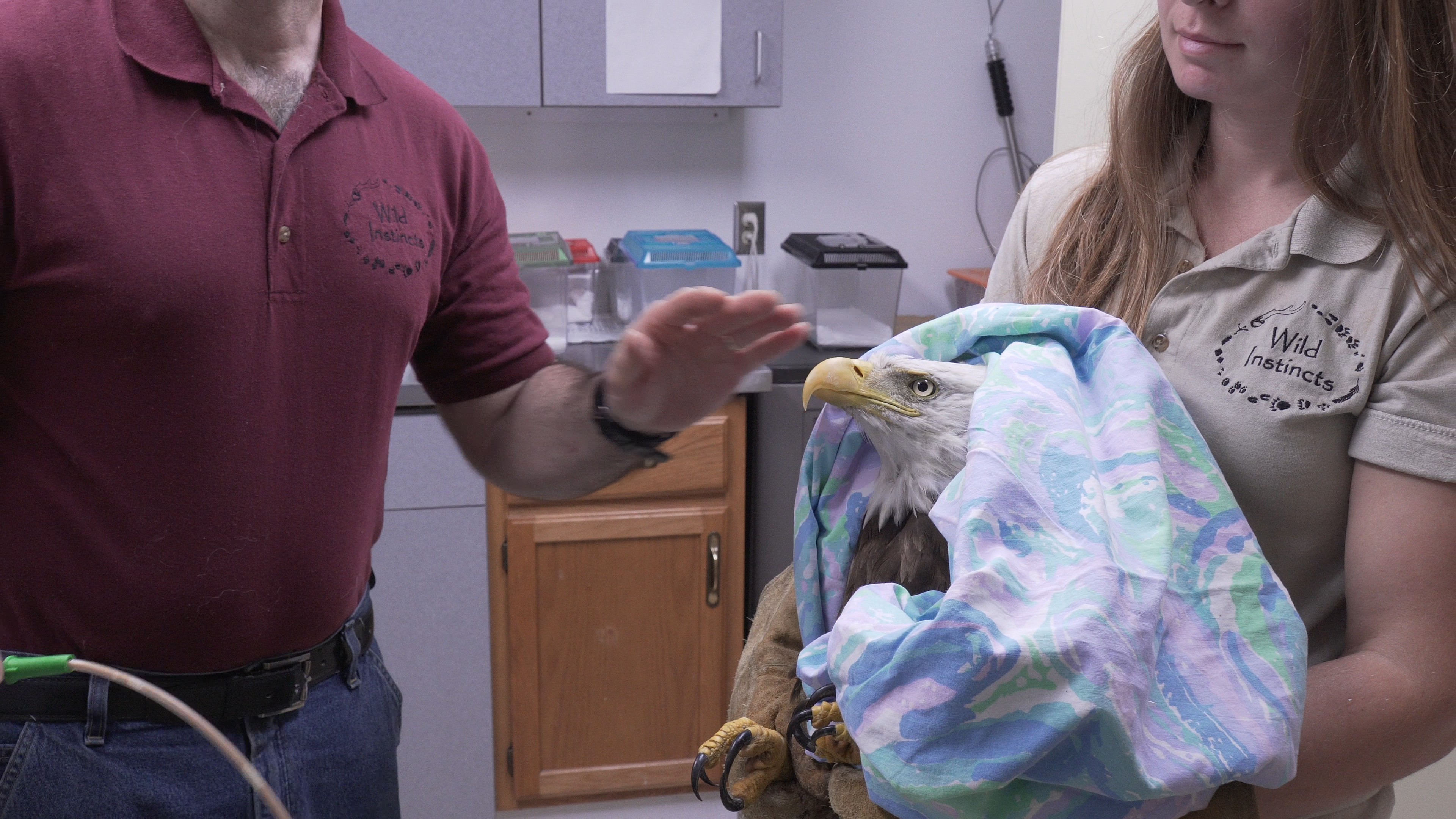
When Jerry Maynard got the phone call about a bald eagle hanging upside down from a tree on the shores of Lake Michigan, two possibilities for the bird’s behavior occurred to him: either it was infected with West Nile virus or it was suffering from lead poisoning. Either way, it clearly needed help.
Unable to collect the bird himself, Maynard, a co-founder and co-director of the Chocolay Raptor Center, told two Upper Peninsula residents how to safely retrieve the eagle and care for it overnight.
The next day he retrieved the eagle from its short stay in a dog pen and, consulting with Mark Naniot, the director of rehabilitation and co-founder of Wild Instincts, he tested the bird for lead. The analyzer, which measures blood lead levels, tops off at 65—and this eagle was above that, at a level where only about 5 percent of birds survive and recover.
Naniot, who has more experience with eagles, immediately began a chelation treatment with a drug called EDTA, which binds to the lead and allows it to be excreted in urine. After days of injections, plus treatment for dehydration and emaciation, the eagle’s lead levels were under the toxic baseline. It even gained almost 1,000 grams of weight, after losing much of its mass due to the near-lethal dose.
That’s not to say this bird is out of the woods just yet. Such high levels of lead exposure affect the bird’s whole body, sometimes in ways that aren’t immediately apparent.
“Just because we’ve got the lead out of the system doesn’t mean there wasn’t some permanent internal organ damage,” Naniot said.
Even with its uncertain future, this eagle is one of the luckier birds. Wild Instincts has taken in 34 eagles this year, 28 of which had lead poisoning. Some get it from eating fish that have swallowed lead fishing tackle. Others may be poisoned by eating the remnants of deer and other game shot with lead bullets.
“Many years we get eight to ten eagles within two weeks after the deer gun season,” Naniot said.
But the mere fact that so many eagles require treatment and rehabilitation is, in itself, a sign of the bird’s successful recovery.
Bald eagle recovery ‘beyond anything we could’ve imagined’
Fifty years ago, the future of bald eagles in the Great Lakes region was far from certain. The pesticide DDT caused eggshell-thinning for numerous birds, and other chemical biproducts like PCBs resulted in even more health issues. Between 1956 and 1996, not a single eagle nested along Lake Ontario. The numbers of nesting pairs around the other Great Lakes hovered around three or four throughout the 1970s.
“The first time I ever saw an eagle nest was in 1977 or ’78,” said William Bowerman, an environmental scientist at the University of Maryland who has been studying eagles for over 30 years and was on the federal recovery team for the species. When Bowerman saw the bird nest, he didn’t realize it belonged to one of the only breeding pairs in Michigan’s Upper Peninsula.
“We didn’t know if they would recover. It was pretty iffy at that stage in time,” Bowerman said.
But several measures were enacted to help the iconic birds: outlawing the use of DDT and protecting the birds’ habitat.
Despite PCBs and other dioxin-like chemicals that are still hanging around in the environment, the eagles managed to recover. The goal in the 1980s was to bring back 1,200 breeding pairs across an entire swath of the country, from western Maryland to Montana. Today, Wisconsin and Minnesota have over 2,500 breeding pairs within their state boundaries.
“They have recovered beyond anything we could’ve imagined,” Bowerman said. “I would rather work myself out of a job by having my species that was endangered recover than worry about my research career.”
Climate change, human activity remain problems
Bald eagles still have to contend with plenty of other dangers. They’re sometimes hit by cars while scavenging meat from carcasses on the side of the road, and lead will likely continue to be a problem until its use is replaced with other materials for hunting shot and fishing tackle (though Bowerman noted that neither of these problems is big enough to impact eagles on a population level).
Human activity also will always lead to some uneasiness in cohabitation with birds. Keith Grasman, a professor of biology at Calvin University who studies water birds like gulls and terns (both of which were similarly affected by DDT and PCBs), said we have reason to celebrate a victory with eagles, but should still remain vigilant.
“Between things like climate change, our impacts on Great Lake food webs by the introduction of invasive species, and pollution, birds in the Great Lakes are still facing a number of ecological impacts from human activity,” Grasman said. “Certain aspects of bird populations did respond to measures put in place, but in the big picture we still have a lot of human activity in the ecosystem.”
At least sometimes those humans are more than happy to take care of an eagle they find upside-down in a tree.
1 Comment
-
How is the upsidedown eagle doing?




